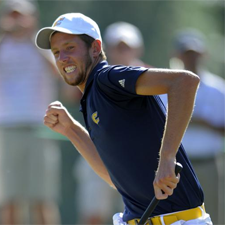As we all saw in person or on NBC, the 112th U.S. Amateur concluded at Cherry Hills CC on August 19th with Steven Fox’s birdie to win the first extra hole of the final match and defeat Michael Weaver in 37 holes.
Now let’s rewind to when the U.S. Amateur started on August 13th. That’s when 312 of the world’s best amateurs teed it up at both Cherry Hills and CommonGround for 36 holes of stroke play (one round at each course) before the field was cut to the low 64 players to make up the match play tree that was contested at Cherry Hills. Steven barely snuck in to match play as the 63rd seed in a playoff. But once he made it to match play, his strength in that format carried him through to the finals.
The U.S. Amateur is one of the most unique televised golf championships as it uses both stroke and match play formats to determine a champion. While most PGA Tour events produce a winner after four rounds, The U.S. Amateur champion tees it up nine times in seven days. Players that advance out of the 36-hole stroke play portion have to quickly transition into match play mode, which comes with a different mindset and a little different set of Rules. The following are some of the main differences between stroke play and match play when it comes to the Rules of Golf.
General penalty — Rules 2-6 (Match Play) and 3-5 (Stroke Play). Match play consists of one player/side competing directly against another and the winner of a match is the player/side that is more holes up than there are left to play. The general penalty for breaching a Rule is a loss of hole penalty. In stroke play, the winner is decided by the person who is playing against the entire field and plays the competition in the lowest number of strokes, therefore the general penalty for breaching a Rule is two strokes. You can find the General Penalty statement at the end of each Rule.
Practice prior to/between rounds — Rule 7-1. As this Rule is written, a player may practice on the competition course prior to his match, but may not practice on the competition course prior to a stroke play round. The penalty for practicing prior to your round in stroke play is disqualification. The committee may adopt a note to this Rule that prohibits practice prior to a match, or permits practice prior to a stroke play round, but those are exceptions to the norm.
Order of play — Rules 10-1 and 10-2. In both forms of play there is no penalty, however, in match play if you or your partner plays out of turn anywhere on the course, your opponent has the option to recall your stroke and make you replay it, or let you play it as it lies. If you hit it in a lake, expect him to be pretty tight-lipped! In stroke play, there is no penalty for playing out of turn provided that if you do play out of turn, it is not to give another player an advantage.
Teeing ground — Rule 11-4 and 5. These Rules are very similar to Rule 10 (Order of play) when dealing with match play, the difference being that Rule 11-4 and 5 pertain to what happens if you play from outside of the teeing ground (regardless of the order) or from the wrong teeing ground. While in match play your opponent has the option of recalling the stroke, in stroke play the penalty is much more severe. If you play from outside the teeing ground or from the wrong teeing ground, there is a two-stroke penalty and the error must be corrected. This means you have to play from inside the teeing ground or from the correct teeing ground. Failure to correct this error before teeing off from the next teeing ground, or before leaving the putting green of your last hole of the day, results in disqualification.
Holing out — Rule 2-4 and 3-2. In match play, it is up to your opponent to determine if you can hole your next shot, therefore he can concede your next stroke. In stroke play, you are playing the entire field so you have to hole out on every hole. If you fail to do so without correcting this before playing from the next teeing ground or leaving the putting green of your last hole of the day, you are disqualified.
As you can see some Rules are much harsher than others when it comes to match play versus stroke play. These are just a few of the differences between the two, and these differences are the reason why it is not permitted in the Rules of Golf to play both forms of play in the same round.
In the wake of the 2012 U.S. Amateur at Cherry Hills, the Solheim Cup is coming to Colorado Golf Club in 2013–so get your tickets, grab your red hat, white golf shirt and blue shorts, and brush up on your match play rules!


